How to properly plant garlic in spring
Let's talk about one of the oldest plants on Earth. It is renowned as a healer for many diseases, including respiratory viral infections. With its addition, various dishes and even ice cream are prepared. One of the cities in the United States, Chicago, is named after him. Today we will talk about garlic.
We will learn how to plant, water and store it correctly, how and when to feed it, as well as other features of plant care.
The content of the article
What is the difference between spring sowing and winter sowing
The main advantage of planting garlic in spring is that the planting material will be of better quality. The teeth that have defects or diseases will simply not last until the spring planting. This means that the future harvest will be healthier. In addition, there is no risk that winter crops will die from autumn frosts.
The disadvantages of landing in the spring include:
- plants less resistant to spring cold and frost;
- weeds appear before shoots, "clogging" them;
- later ripening of the crop.
Winter and spring garlic
These species differ by planting dates: winter is planted in autumn, spring - in spring. Some gardeners plant spring crops before winter and vice versa, but this method is not very popular.
About winter crops
Distinctive features of winter crops are:
- the winter garlic bulb is usually larger, divided into 6-10 cloves, also quite large;
- winter culture is not afraid of frost, as it is hardened in autumn;
- the cloves of winter garlic are even, located strictly around the arrow, which is cut off during the formation of the heads - a solid stem remains;
- the shelf life is not too high, although there are also decaying varieties, it is recommended to use winter spice before the new year;
- winter garlic ripens and is completely ready for consumption and storage in July-August.
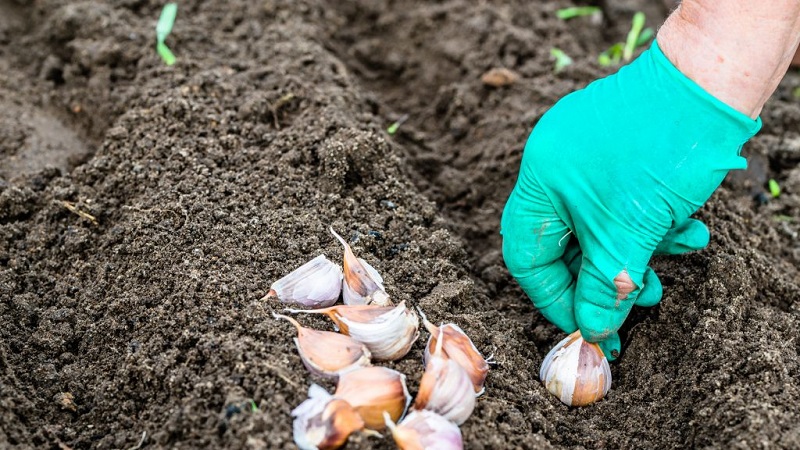
Spring brother
Spring varieties have the following differences:
- spring garlic is afraid of cold weather, low temperatures are destructive for it;
- the spring culture bulb is smaller, the teeth are also smaller, but there are much more of them - up to 30 pieces;
- the arrangement of the teeth is chaotic;
- spring garlic does not have an arrow;
- the shelf life, in comparison with winter crops, is much longer, usually the vegetable lies before the new harvest.
Is crop rotation important for garlic?
Let's figure out how to properly plant garlic cloves in spring. In general, the cultivation technology when planting for winter and spring differs only in the time when field work begins. Otherwise, the processes are identical.
Ideally, plant garlic after green manure or mustard plants. These crops will prepare the soil and saturate it as much as possible with nitrogen, potassium and phosphorus, necessary for the growth and development of garlic. Siderata are sown immediately after harvesting, then they are dug up or plowed over.
In addition to siderates, zucchini, squash, cucumbers, berry bushes will be the optimal precursors for planting spices. It is even allowed to plant garlic between the rows of strawberries.
Plant a crop after carrots, beets or onions are not recommended. Carrots deplete the soil, and onions not only "feed" on the same microelements as garlic, but can also infect the soil with diseases common to garlic, because they are from the same family.
Varieties and seed preparation
It is advisable to choose a variety based on climatic conditions.It is best to harvest the seed within a 100 km radius of the planting site - these varieties are usually optimal for the climate and soil.
When selecting seeds for planting, pay attention to the following:
- the cloves are taken from such bulbs where there are no damaged or spoiled teeth: there should be no rot and mold;
- degenerating garlic is not the best option for planting, even if it is well preserved (too large teeth (there are no more than 3-5 of them), spliced or having two ends, or too different in size testify to degeneration).
Gardeners with enough experience advise placing the selected seed material in a damp cloth, and then in a refrigerator or other cool place. To accelerate germination, it is recommended to warm prepared teeth for up to 10 hours in warm water. Its temperature should not exceed 42 ° C. Before planting, the seeds are treated with a solution of 1% copper sulfate or ordinary potassium permanganate. The seed is soaked for a day.
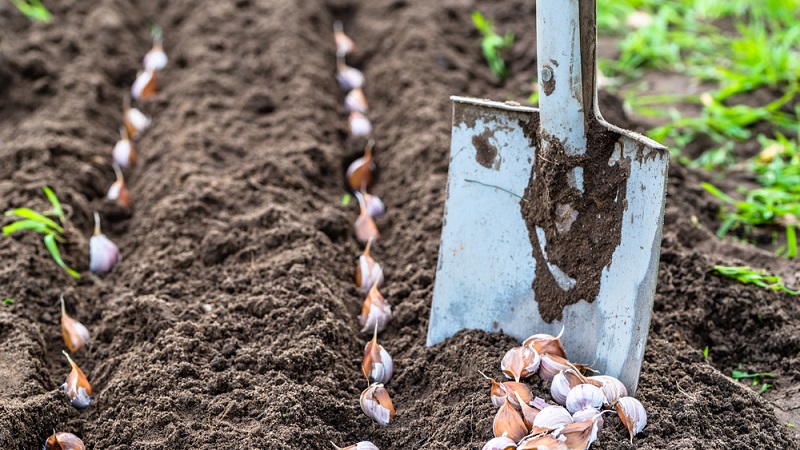
A little about varieties
There are many varieties of garlic, both winter and spring. Let's consider the characteristics of some of them.
Winter varieties:
- Alcor is a shooting variety. Ripening period - 87-98 days, head weight - up to 40 g, has good keeping quality and spicy taste;
- Titanium is a shooting grade. Ripening period - 100-115 days. The head weight can reach 150 g, has good keeping quality and pungent taste.
Spring varieties of garlic:
- Abrek is a non-shooting variety. Ripening period - 118-120 days. Head weight - 26-30 g, keeping quality is excellent up to 7-8 months, the taste is very spicy;
- Yelenovsky is a non-shooting variety. EIts peculiarity lies in the fact that it can be planted both in the autumn and in the spring. Ripening period - 110 days. Head weight - up to 35 g. Can be stored for up to two years.
When to plant winter and when to plant spring
For any landing method, the main criterion is not the time frame, but the weather conditions. Often, novice gardeners have a question: is it possible to plant winter garlic in spring in May? It all depends on the weather conditions. Thus, spring garlic is planted from March to May, depending on the region.
In the south, they begin to land in mid-March, in the middle lane - in mid-April - early May, in the north - in May. Sow garlic when the soil temperature is 3-5 ° C.
Winter garlic is planted in the same way, depending on the climate, from September to November. Ideally, planting is done 1-1.5 months before the first frost begins. The plant must have time to take root and get stronger, so as not to die in the cold.
The gardener must decide when it is better to plant garlic, in spring or autumn, taking into account the climate, soil condition and the chosen variety. Autumn varieties ripen faster, while spring varieties are stored better and longer.
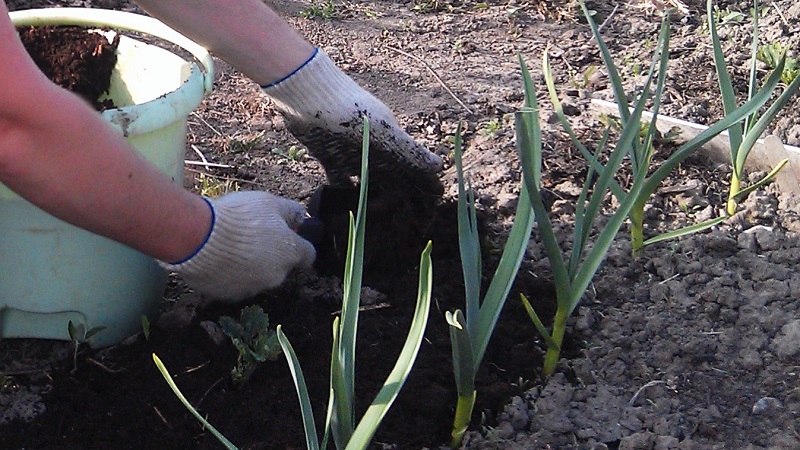
The place and the garden are important
The place for garlic should be sunny, where water does not stagnate and snow does not linger. Both types of garlic love tall beds. When using them, the chance of the appearance of fungal diseases from waterlogging is significantly reduced. The recommended height of the beds is 20 to 25 cm and 1 m wide. It is better to cook the garden in the fall (for any planting method).
Information on how to improve the soil is given in the table.
The proportions are given per 1 sq. m:
| Soil type | What to contribute |
| Sandy soil | Peat bucket, 2 clay buckets |
| Clay soil | Bucket of sand, bucket of loamy soil |
| Clay soil | Peat bucket, sand bucket |
| Organic compounds to enrich any type of soil | 1 tbsp. l. superphosphate and potassium sulfate, 2 tbsp. l. wood ash, 1 cup of chalk, 10 kg of humus |
The composition for enriching the soil is evenly scattered over the garden bed, the site is dug to the depth of the shovel bayonet. Then the bed must stand so that the soil subsides after the rains. If there is little rainfall, it is better to shed the bed yourself. If you plant garlic in unsettled soil, then the tines will also sink deeper in the process of soil subsidence. So it will be much more difficult for them to germinate.This applies to the autumn planting. Until spring, the soil will sag in any case.
Before spring planting, it is advisable to level and loosen the ground. Garlic is planted in holes or furrows. The distance between furrows should be about 25 cm, and between the teeth - 8-12 cm, depending on the size of the planting material. The recommended distance between holes is 10 cm. The depth of the spring planting will be up to 4 cm.
This is followed by watering. Experienced gardeners advise covering the garden bed with mulch (sawdust, peat or straw) to a height of 3 cm.
Important! When planting, do not press the teeth into the ground - they will germinate longer.
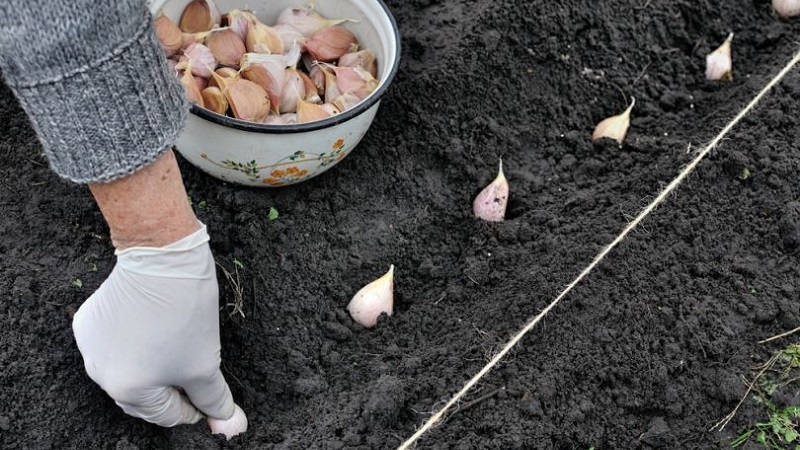
Care features
When the spring garlic forms 3-4 leaves - it's time to feed it (for winter garlic - a week after the snow melts). The second time the procedure is carried out in two weeks. The last one is in mid-July.
Untimely top dressing in the summer is fraught with wasted fertilizer or too raging greens to the detriment of the bulb.
The types of mineral dressings are shown in the table:
| Fertilizer name | How to cook | Consumption | Why do they bring |
| Ammonium nitrate (used no more than once every three weeks) | 15 mg fertilizer per 10 l of water | 3 liters per 1 sq. m
|
Replenishes nitrogen deficiency
|
| Urea | 1 st. l. for 10 liters of water | 3 liters of solution per 1 sq. m | Replenishes nitrogen deficiency |
| Superphosphate | 2 tbsp. l. for 10 liters of water | 2 sq. m | Replenishes the lack of phosphorus |
| Nitroammofoska | For foliar treatment of plants: 1 tbsp. l. per 10 liters of water (when applied to the soil, the dose of the drug is doubled) | Spray foliage in a volume for which there is enough solution | Replenishes the lack of potassium, phosphorus, nitrogen, sulfur |
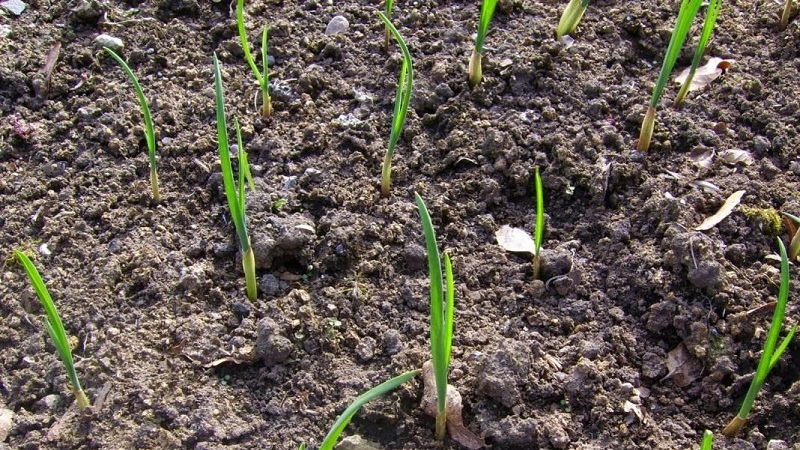
The following are the types of organic dressings:
| Fertilizer name | How to cook | How to use | Why do they bring |
| Wood ash | Immediately scattered over the beds or insist for a day 0.5 liters of ash per 10 liters of water | The composition is poured over the soil | Enrich the soil with potassium and phosphorus |
| Ammonia | 25 ml of ammonia per 10 l of water | Spray on plant feathers, you can water the soil, but before planting | Enrich the plant with nitrogen |
| Raw yeast | 200 g of yeast per 1 liter of water, infuse for 24 hours and add up to 10 liters | Sprinkle the garlic | Enrich the vegetable with amino acids |
Watering garlic of both types is carried out according to the same scheme:
- there is no watering in rainy and cloudy weather;
- in moderate heat with light rainfall, watered once a decade or a week;
- in dry summers, watering is done every five days.
After watering or heavy rain, they must close the moisture: the top layer of the soil is carefully loosened when it becomes slightly grayish instead of black. In the case of winter garlic, moisture should be covered in early spring.
Important! Plants that are properly looked after are least susceptible to diseases and pests. Garlic that has received all the nutrients rarely suffers from pests or diseases.
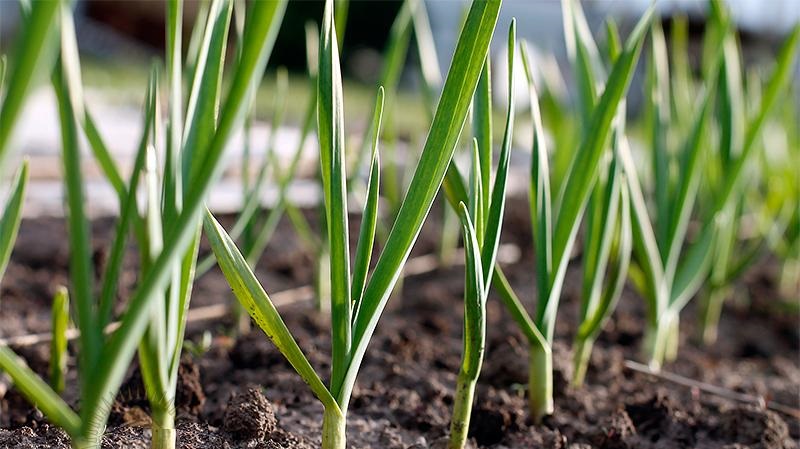
How to collect and save
Its keeping quality directly depends on the timeliness of the harvest. Garlic dug too early rots quickly and is not as tasty. Late harvested fruits are also poorly stored, the head crumbles into teeth. The palatability is also lost.
Collection time
How to recognize the degree of ripeness of garlic? There are several signs:
- the first sign of the ripeness of garlic - the entire upper part of the plant or its lower leaves begin to dry out;
- it is easy to determine the degree of maturity by digging up a few onions: mature husks will be completely dry, lilac-white in color. Garlic "wrapped" in three layers of husk is best stored;
- the teeth of a ripe plant are elastic, separate from each other without difficulty, but they should not crumble either;
- in non-shooting garlic, at the time of ripeness, the root neck easily separates from the teeth and is dry;
- to determine the ripeness of arrowed garlic in several plants, an arrow is left. A ripe plant is characterized by the unwinding of the arrow and the full disclosure of the inflorescence itself.
We remove correctly
When harvesting, it is better to hurry up literally 1-2 days before the full ripeness of the garlic. This will make it easier to preserve its taste and beneficial properties.
Dig the plant with a shovel, because the bulb is damaged during the pulling out. Also, you cannot clean it of dirt by knocking plants against each other or on a shovel. Such fruits will also be damaged, and you can not count on their long-term storage. Manually peel the soil.
After the garlic, especially slightly unripe, should be "brought" and dried. To do this, it is suspended, without separating from the stem, in the shade. For example, under a canopy or in any room with good air circulation. This method allows you to improve the taste of the spice, all the nutrients from the tops go directly to the head. This bulb contains more nutrients and better taste.
We save the harvest
For storage, the onions are selected strong, whole, without traces of rot and damage. Even one slightly rotten garlic can nullify all the gardener's efforts in winter.
The fruit should be stored away from light, in a dark and cool (from 2 to -2 ° C) room. A cellar, basement, dry insulated attic are suitable for this. There are many storage methods, for example:
- hanging in braids;
- in plywood boxes;
- in cardboard boxes;
- in cloth soaked in salt and dried bags;
- In oil;
- slices, dipped in paraffin.
For storage in apartments, other methods are suitable. One of them is putting garlic in jars, whole or disassembled into cloves. The husk does not need to be peeled. Storage containers are washed, dried or sterilized well, and then the bulbs are laid.
For pouring the fruits, use onion peels, ash, salt, flour, expanded vermiculite. You can simply put it in sterile jars and roll it up. The longest and highest quality storage is freezing.

Read also:
What happens if you eat garlic every day.
Conclusion
Garlic is not only a healthy plant, but also a delicious seasoning, without which many simply cannot imagine their cuisine.
Now you know how to plant spring garlic in spring and what are the main subtleties of growing this spicy crop. Even a novice gardener can handle planting and leaving. Garlic will not cause much trouble for its owner.